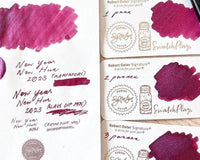A fountain pen is only as good as the ink a writer fills it with. After all, without fountain pen ink, it wouldn’t be possible to use our favorite elegant writing instruments. Choosing an ink can be incredibly fun and rewarding since so many options are available today. However, it can also be daunting, especially for beginners. Where could one possibly start with the vast array of colors and ink types on the market? Here, we’ll walk you through the different characteristics of fountain pen inks so you can choose the right one for you.
How to choose fountain pen ink
There are many things to consider when choosing the right fountain pen ink for your needs and preferences.
Bottled ink vs. cartridges

One of the first decisions you have to make when choosing a fountain pen ink is whether you should buy it bottled or in a cartridge. Some pens are designed and manufactured in such a way that they can only use one or the other, which can make the decision-making much simpler on your end. Many pens can take both. In this case, it’s good to look at the pros and cons of both bottled ink and cartridges.
|
Pros |
Cons |
|
|
Bottled Ink |
Wide selection of colors Low long-term cost Waterproof options |
Harder to refill Needs a separate converter More expensive initially Not as convenient for travel |
|
Cartridges |
Low initial cost Convenient to use Easy to replace |
Not as many colors Few waterproof choices More expensive long-term |
Flow
Flow is another important fountain pen ink quality to consider when choosing. This refers to how well ink can flow through a fountain pen. Some fountain pen users call this the ink’s “wetness.” Many people enjoy using fountain pen inks that flow easily, which provides a smoother writing experience. However, this can also lead to more feathering and bleeding, depending on your paper. Other writers prefer inks with a more restrictive or “drier” flow. Getting samples is a great way to test out your preferred flow before committing to a full bottle of ink.
Color

Choosing an ink color is entirely up to your personal preference. We recommend looking through color swatches of various inks until you find one that suits your fancy. If you have samples, it can be very helpful to swatch them using something like Wearingul’s Ink Color Swatch Book so you can see what they look like on paper. A swatch book or swatch cards also allow you to view several colors at a glance.
Waterproofness
How waterproof an ink is refers to its ability to be unaffected by water. Many fountain pen inks are not waterproof or water-resistant, so pay attention to the details of the formula before making your decision. There are three levels of waterproofness, the first being waterproof ink, which (once dry) is permanent and completely water-resistant. The second is water-resistant ink, which will not wash away with water but is likely to smudge. Lastly, non-water-resistant ink can easily be washed away with water and is not recommended for users who want some permanence to their writing.
Composition

Fountain pen ink composition refers to the type of colorant the manufacturer uses when making the ink. Each type has its own unique attributes that can help you decide which ink is right for you.
Dye-based ink. Dye-based inks are the most common type of fountain pen ink and are suitable for beginners. They come in many colors and are very versatile. Brands such as Diamine, Robert Oster, and Wearingeul produce a wide variety of colors for their dye-based fountain pen inks.
Pigment-based inks. Pigment-based inks are more budge-proof than dye-based inks. However, their permanence also means that there is less color variety available. These inks are also harder to maintain, so it is advisable to follow best practices in fountain pen maintenance and cleaning when using these types of inks in your pens.
Iron gall inks. Another class of highly waterproof fountain pen ink is iron gall ink. These are typically made from natural ingredients that change color as they dry. This type of ink often has an interesting shading effect due to its composition.
Shimmering and sheening inks. Glittering and sheening particles have been added to many modern fountain pen inks in recent years to give a more beautiful effect on paper. These are safe to use as long as you practice good pen hygiene.
The Bottom Line
Choosing a fountain pen ink can be intimidating at first, especially if you are new to fountain pens. By using this guide, you can select the best fountain pen ink for you based on your needs and preferences for color, flow, composition, and more.
Happy inking, and happy writing!
Written by EndlessPens Blogger Ramona Kabigting







